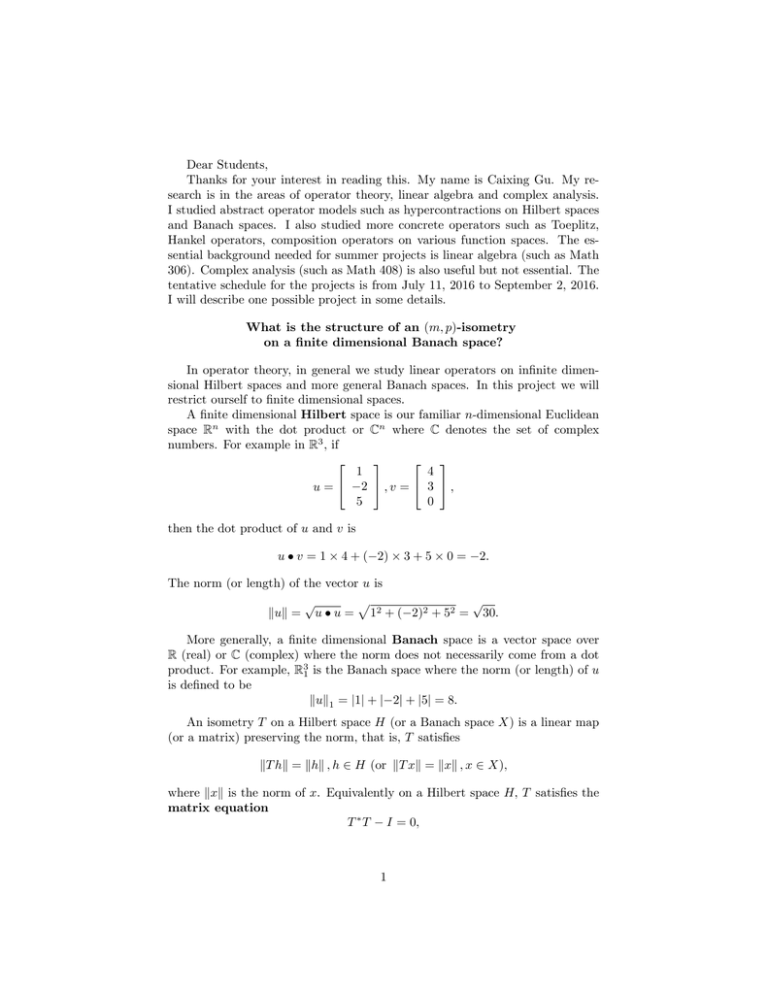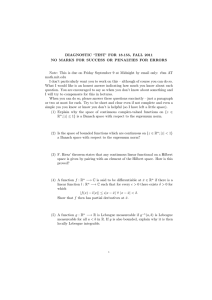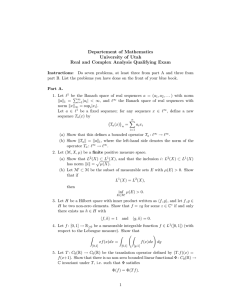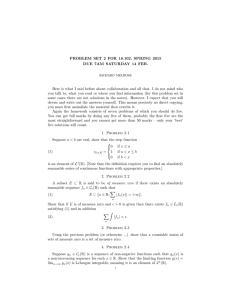Dear Students,
advertisement

Dear Students, Thanks for your interest in reading this. My name is Caixing Gu. My research is in the areas of operator theory, linear algebra and complex analysis. I studied abstract operator models such as hypercontractions on Hilbert spaces and Banach spaces. I also studied more concrete operators such as Toeplitz, Hankel operators, composition operators on various function spaces. The essential background needed for summer projects is linear algebra (such as Math 306). Complex analysis (such as Math 408) is also useful but not essential. The tentative schedule for the projects is from July 11, 2016 to September 2, 2016. I will describe one possible project in some details. What is the structure of an (m; p)-isometry on a Önite dimensional Banach space? In operator theory, in general we study linear operators on inÖnite dimensional Hilbert spaces and more general Banach spaces. In this project we will restrict ourself to Önite dimensional spaces. A Önite dimensional Hilbert space is our familiar n-dimensional Euclidean space Rn with the dot product or Cn where C denotes the set of complex numbers. For example in R3 ; if 2 3 2 3 1 4 u = 4 !2 5 ; v = 4 3 5 ; 5 0 then the dot product of u and v is u " v = 1 # 4 + (!2) # 3 + 5 # 0 = !2: The norm (or length) of the vector u is p p p kuk = u " u = 12 + (!2)2 + 52 = 30: More generally, a Önite dimensional Banach space is a vector space over R (real) or C (complex) where the norm does not necessarily come from a dot product. For example, R31 is the Banach space where the norm (or length) of u is deÖned to be kuk1 = j1j + j!2j + j5j = 8: An isometry T on a Hilbert space H (or a Banach space X) is a linear map (or a matrix) preserving the norm, that is, T satisÖes kT hk = khk ; h 2 H (or kT xk = kxk ; x 2 X), where kxk is the norm of x. Equivalently on a Hilbert space H; T satisÖes the matrix equation T ! T ! I = 0; 1 where T ! is the transpose of the matrix T and I is the identity matrix. For example in R3 ; a rotation is an isometry. The matrix of a rotation in R3 looks like 2 3 cos . sin . 0 4 ! sin . cos . 0 5 : 0 0 1 Isometries are very useful in engineering applications and computer graphics. Agler (1990), and Agler and Stankus (1995) introduced the concept of a 2-isometry T on an inÖnite dimensional Hilbert space K to be an operator satisfying T !2 T 2 ! 2T ! T + I = 0; more generally, an m-isometry T for a positive integer n if ' ( m X m !k k (!1)k T T = 0: k k=0 For p 2 [1; 1); Bayart (2011) introduced the concept of a (2; p)-isometry T on an inÖnite dimensional Banach space X to be an operator satisfying ) 2 )p )T u) ! 2 kT ukp + kukp = 0 for all u 2 X; where kuk is the norm of u; more generally, an (m; p)-isometry T for a positive integer n if ' ( m X ) ) k m ) k )p (!1) T u = 0 for all u 2 X: k k=0 The (2; p)-isometry (or the (m; p)-isometry) is a generalization of the isometry since if T is an isometry, i.e., kT uk = kuk then and ) 2 ) )T u) = kT T uk = kT uk = kuk ) 2 )p )T u) ! 2 kT ukp + kukp p p p = kuk ! 2 kuk + kuk = 0: In other word, an isometry is always a (2; p)-isometry. In this project, we will try to characterize (m; p)-isometries on a Önite dimensional Banach space X: The answer is known in literature on a Önite dimensional Hilbert space H over C as follows: T on H is an m-isometry if and only if T =U +N where U is an isometry on H and N is a nilpotent operator (i.e., N l = 0) such that U N = N U: 2






